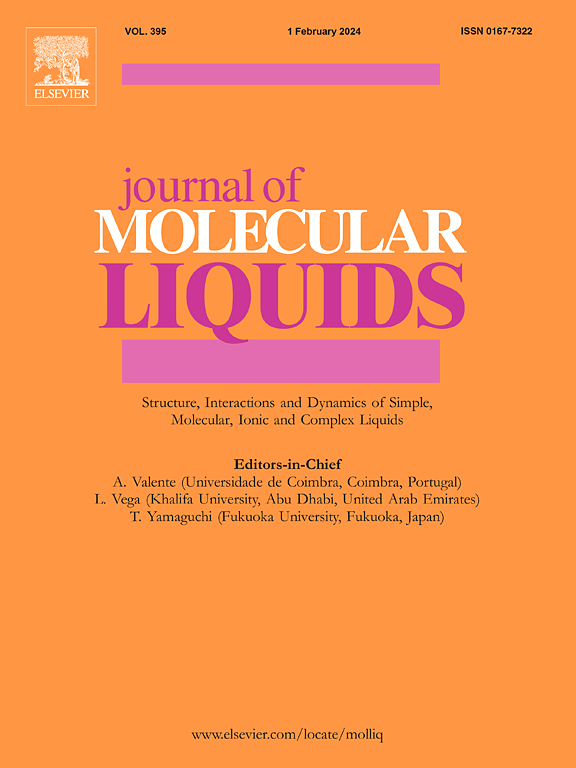全面回顾影响泡沫稳定性的关键机制和参数
IF 5.3
2区 化学
Q2 CHEMISTRY, PHYSICAL
引用次数: 0
摘要
泡沫在废水处理、提高石油采收率、食品、药品和化妆品制造以及消防等各行各业都有应用。因此,全面了解泡沫及其带来的挑战至关重要。这篇综合评论文章详细分析了泡沫的产生、稳定性和破裂过程,强调了物理和化学参数的影响。泡沫具有复杂的结构和独特的特性,在石油天然气、食品生产、医疗保健和制药等众多工业领域发挥着至关重要的作用。泡沫的稳定性受多种因素影响,如气体类型、溶液成分(包括表面活性剂、pH 值、聚合物和纳米颗粒)以及操作条件(如温度和注入压力)。这些因素都会通过改变液相和气相的物理和化学性质来影响泡沫的稳定性。本综述深入探讨了表面活性剂在降低表面张力方面的作用、纳米粒子在增强泡沫结构方面的应用,以及聚合物作为增稠剂和稳定剂的功能。这些材料通过调节液相行为、降低排水率和防止气泡凝聚来提高泡沫稳定性。此外,本综述还严格评估了温度和注入压力等操作变量对泡沫稳定性的影响。温度升高会导致液体排出量增加和气泡凝聚,但通过使用适当的化合物(如耐高温表面活性剂和纳米颗粒)以及增加注入气体的压力,可以减轻这些负面影响。此外,溶液中的盐含量和 pH 值也会改变液相的静电特性,从而对泡沫稳定性产生重大影响。本综述得出的结论强调了优化材料和工艺条件组合以提高泡沫稳定性的有效性。本研究为今后旨在改进和开发高稳定性泡沫的研究奠定了坚实的基础,并可作为工程师和研究人员寻求优化泡沫相关工艺的宝贵参考资料。本文章由计算机程序翻译,如有差异,请以英文原文为准。
A comprehensive review on key mechanisms and parameters affecting foam stability
Foam finds applications in various industries such as wastewater treatment, enhanced oil recovery, and the manufacturing of food, medicine, and cosmetics, as well as in firefighting. Therefore, having a thorough comprehension of foam and the challenges it presents is crucial. This comprehensive review article offers a detailed analysis of the processes involved in foam generation, stability, and rupture, emphasizing the influence of physical and chemical parameters. With their intricate structure and unique characteristics, foams play a crucial role in a wide range of industrial sectors including oil and gas, food production, healthcare, and pharmaceuticals. The stability of foams is influenced by various factors such as the type of gas, solution composition (including surfactants, pH, polymers, and nanoparticles), and operational conditions (e.g., temperature and injection pressure). Each of these factors can impact foam stability by modifying the physical and chemical properties of the liquid and gas phases. The review thoroughly examines the role of surfactants in reducing surface tension, the use of nanoparticles to enhance foam structure, and the function of polymers as thickeners and stabilizers. These materials improve foam stability by regulating the behavior of the liquid phase, reducing drainage rates, and preventing bubble coalescence. Furthermore, this review critically evaluates the impact of operational variables like temperature and injection pressure on foam stability. Higher temperatures can lead to increased liquid drainage and bubble coalescence, but these negative effects can be mitigated by using suitable compounds such as thermally resistant surfactants and nanoparticles, along with increased injection gas pressure. In addition, the salt content and pH of the solution significantly influence foam stability by altering the electrostatic properties of the liquid phase. The conclusions drawn from this review highlight the effectiveness of optimizing the combination of materials and process conditions to enhance foam stability. This study lays a solid groundwork for future research aimed at improving and developing highly stable foams and can serve as a valuable reference for engineers and researchers seeking to optimize foam-related processes.
求助全文
通过发布文献求助,成功后即可免费获取论文全文。
去求助
来源期刊

Journal of Molecular Liquids
化学-物理:原子、分子和化学物理
CiteScore
10.30
自引率
16.70%
发文量
2597
审稿时长
78 days
期刊介绍:
The journal includes papers in the following areas:
– Simple organic liquids and mixtures
– Ionic liquids
– Surfactant solutions (including micelles and vesicles) and liquid interfaces
– Colloidal solutions and nanoparticles
– Thermotropic and lyotropic liquid crystals
– Ferrofluids
– Water, aqueous solutions and other hydrogen-bonded liquids
– Lubricants, polymer solutions and melts
– Molten metals and salts
– Phase transitions and critical phenomena in liquids and confined fluids
– Self assembly in complex liquids.– Biomolecules in solution
The emphasis is on the molecular (or microscopic) understanding of particular liquids or liquid systems, especially concerning structure, dynamics and intermolecular forces. The experimental techniques used may include:
– Conventional spectroscopy (mid-IR and far-IR, Raman, NMR, etc.)
– Non-linear optics and time resolved spectroscopy (psec, fsec, asec, ISRS, etc.)
– Light scattering (Rayleigh, Brillouin, PCS, etc.)
– Dielectric relaxation
– X-ray and neutron scattering and diffraction.
Experimental studies, computer simulations (MD or MC) and analytical theory will be considered for publication; papers just reporting experimental results that do not contribute to the understanding of the fundamentals of molecular and ionic liquids will not be accepted. Only papers of a non-routine nature and advancing the field will be considered for publication.
 求助内容:
求助内容: 应助结果提醒方式:
应助结果提醒方式:


